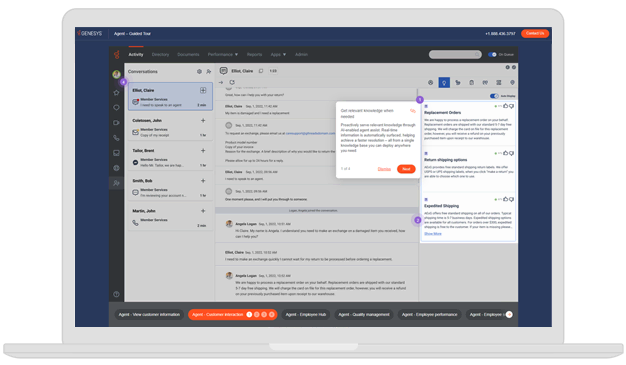Uncover the value of speech analytics
How people feel during a conversation is just as important as understanding what they say. Using speech analytics and sentiment detection tools gives businesses real-time access to the true voice of their customers. This can allow them to transform every call into a source of actionable insight. It’s about listening and responding to those insights.
Speech analytics decodes customer conversations, turning voice data into structured information. Paired with sentiment detection, it not only captures what was said but how it was said. This means it can detect tone, emotion, and even frustration or satisfaction levels.
In this article, we’ll explore how speech analytics and sentiment detection work, the technologies that power them and the impact they’re having across industries.
Understanding speech analytics and sentiment detection
To deliver exceptional customer service, businesses need more than call recordings and post-interaction surveys. Increasingly, customers want to feel heard and understood. To do this, businesses need real-time insights into what customers say and how they feel.
While speech analytics captures and analyzes spoken language from customer interactions, sentiment analysis adds context by identifying emotional tone.
Together, they complement each other to help organizations make smarter decisions, improve agent coaching and personalize service in the moment — by delivering a more accurate, responsive voice of the customer.
What is speech analytics?
Speech analytics transforms spoken conversations into structured data, allowing organizations to analyze large volumes of voice interactions. Using transcription, keyword spotting and pattern detection, it can uncover trends, monitor compliance and evaluate agent performance.
These insights help improve product or service strategies and customer experience, turning call insights into actionable intelligence at scale.
What is sentiment detection in customer conversations?
Sentiment detection uses natural language processing and machine learning to analyze voice cues — like pitch, pace and word choice. With this, it can identify emotions such as frustration or satisfaction.
Integrated with speech analytics, it adds context and flags issues in real time. This allows businesses to intervene faster and manage customer experiences proactively.
Core technologies behind real-time speech analytics
Behind the power of real-time speech analytics and sentiment detection are advanced artificial intelligence (AI) technologies that process and interpret language at scale. Two key technologies — natural language processing (NLP) and machine learning — enable systems to convert unstructured voice data into actionable insights.
NLP deciphers human speech patterns and extracts meaning, while machine learning continuously improves the system’s accuracy by learning from new data. Together, they form the backbone of real-time analytics, helping contact centers detect trends, gauge emotions and take immediate action to improve service delivery.
NLP enables machines to interpret human language in real time. In speech analytics, it converts spoken input into structured, searchable data by identifying keywords, intent and topics — even through accents and casual speech. This allows contact centers, in particular, to monitor compliance, spot emerging issues and understand customer intent accurately — making voice analytics scalable, reliable and much more insightful.
Machine learning algorithms analyze tone, pitch, word choice and pacing to detect emotional cues like frustration or satisfaction. Trained on large datasets, these models continuously refine their accuracy, helping distinguish between neutral and emotionally charged interactions.
They also support predictive capabilities — identifying negative sentiment early so teams can respond proactively and ensure the system evolves with changing language and behavior patterns.
How real-time Voice of the Customer works
Real-time Voice of the Customer AI capabilities turn everyday conversations into immediate, actionable intelligence. Instead of waiting for surveys, combing through online reviews or reviewing call transcripts after the fact, businesses can now analyze interactions as they happen.
This shift allows contact centers to respond in the moment — by adjusting messaging, resolving dissatisfaction or escalating concerns before they become major issues. At the core of this process are two essential steps: capturing live voice data and transforming it into insights that drive decisions across service, operations and strategy.
Capturing and processing live voice data
Capturing live voice data begins the moment a customer starts speaking. Speech analytics platforms use real-time audio streaming to process the conversation instantly, converting it into text through speech recognition technologies.
These systems identify key phrases and emotional cues mid-call — providing a live view of a customer’s positive sentiment or dissatisfaction. It then allows for timely intervention or response before the conversation ends.
Extracting actionable insights from customer reviews and customer calls
After voice data is processed, analytics tools organize it by sentiment, topic and outcomes — revealing trends across conversations. These insights help identify systemic issues, flag at-risk customers and uncover coaching opportunities.
Real-time dashboards ensure the right people get timely alerts, enabling faster decisions and more personalized service. It’s a continuous loop that drives proactive customer experience improvements.
Key benefits of speech analytics
Once customer conversations are captured and analyzed in real time, organizations can act on that intelligence to drive meaningful outcomes. For US-based businesses, speech analytics and sentiment detection offer clear competitive advantages — especially in markets where expectations for speed, personalization and empathy are higher than ever.
These tools can not only enhance the customer experience but also empower employees, optimize operations and reduce service costs. By turning voice data into strategy, companies can respond to customer needs with precision and deliver standout service at scale.
It’s important to note that regulations for speech analytics and sentiment detection can vary significantly from country to country.
Enhancing customer experience and satisfaction
Real-time sentiment detection captures customer emotions during live interactions, allowing agents to respond with empathy and managers to step in when needed. Automated systems can also adjust tone or messaging instantly.
This helps improve satisfaction and loyalty while identifying recurring friction points, like unclear policies or process gaps. It’s a proactive approach to experience management, driven by live emotional feedback rather than after-the-fact analysis.
Improving agent performance and operational efficiency
Speech analytics provides real-time insight into all interactions, helping managers identify trends across interactions, coaching opportunities and compliance gaps. Aspect-based sentiment analysis cues reveal where agents may struggle to connect emotionally, allowing for targeted feedback.
On the operations side, automation reduces manual monitoring, speeds up resolutions and improves resource allocation — enhancing performance and efficiency without adding staff.
Challenges and considerations in implementation
While the benefits of speech analytics and sentiment detection can be substantial, successful implementation isn’t without its hurdles. US businesses must address important regulatory, technical and operational considerations before deploying these technologies at scale.
From protecting sensitive customer data to ensuring that language and tone are interpreted correctly across diverse populations, it requires balancing innovation with responsibility. This section explores two of the most critical challenges: maintaining compliance and ensuring system accuracy.
Data privacy and regulatory compliance
Collecting and analyzing customer voice data comes with legal and ethical responsibilities. In the US, it requires strict compliance with laws like HIPAA, TCPA and CCPA.
Businesses must obtain clear consent, protect personally identifiable information (PII) and ensure secure data storage. AI-powered systems should be designed to minimize bias and support transparency. Partnering with providers that prioritize compliance and ethical standards helps build trust, maintain your brand reputation and reduce the risk of regulatory penalties.
Ensuring accuracy and overcoming language nuances
Speech analytics software must accurately interpret accents, dialects, slang and emotional tone to avoid errors in transcription or sentiment detection. While machine learning improves accuracy over time, systems still need thoughtful tuning and diverse, representative training data.
Especially in US contact centers that serve diverse populations, capturing both the words and the intent behind them is essential for delivering reliable insights and meaningful customer understanding.
Selecting the right speech analytics solution
A growing number of providers offer speech analytics and sentiment detection tools. Choose a solution that balances functionality, security and compatibility to ensure your investment supports real-time voice intelligence at scale.
Look for tools that offer more than just transcription. They should also provide insights, seamless integration and the flexibility to evolve with your business.
Speech analytics tools are most effective when they integrate seamlessly with existing tools like CRM systems. Open APIs and built-in connectors help contextualize voice data with customer history and interaction records.
This can help to improve text analysis accuracy and supports automated workflows, such as triggering follow-ups or supervisor alerts. The right solution should enhance operations — not add complexity.
Future trends in speech analytics and sentiment detection
Driven by advances in AI and evolving customer expectations, these technologies are becoming smarter, faster and better integrated across channels, such as voice, email and social media platforms. In the future, expect more opportunities to use voice data to shape real-time experiences, improve decision-making and predict future outcomes. The following trends offer a glimpse into what’s next for this space.
AI advancements and predictive analytics
The next generation of speech analytics will be driven by more sophisticated AI, including deep learning and large language models. These can offer richer context and improved emotion recognition, which can help businesses in better identifying customer needs.
Predictive analytics will help businesses anticipate needs, detect churn risks and resolve issues proactively. As these models integrate with workforce and journey tools, real-time insights will evolve into predictive, actionable intelligence — enabling faster, smarter decisions.
The channel-less approach to Voice of the Customer
Voice is no longer the only channel that matters as customers often engage across multiple platforms in a single journey. Future speech analytics solutions will expand their reach, connecting insights from all channels to create a unified view of sentiment and experience.
This channel-less approach will reveal the full context behind each interaction, enabling businesses to deliver more personalized, consistent and service on any channel —seamlessly. Voice of the Customer will become Voice of the Journey — captured, analyzed and acted on wherever conversations happen.
Orchestrated experiences and your competitive advantage
Speech analytics and sentiment detection are reshaping how businesses understand and engage with their customers. By capturing real-time voice data and emotional cues, these technologies go far beyond traditional metrics. They can deliver deeper insights, faster responses and smarter decisions across the contact center.
As AI continues to advance, and as customer journeys span across multiple channels, the ability to act on voice intelligence in the moment will become a defining advantage.
Frequently asked questions
How accurate is real-time sentiment detection?
It’s increasingly accurate, often reaching 75–90% precision depending on the quality of data, model training and language nuances. Advanced systems combine tone, word choice, pacing and context to detect emotions like frustration or satisfaction. However, accuracy can vary with accents, sarcasm and cultural differences — so human oversight remains important.
What industries can benefit most from speech analytics?
Industries with high customer interaction volumes benefit most. This includes contact centers, financial services, healthcare, retail and telecommunications. These sectors use speech analytics to improve customer support, ensure compliance, detect churn risk and enhance agent performance. Public sector and insurance organizations also use it for quality assurance and fraud detection.
Is it difficult to implement speech analytics in existing systems?
Implementing speech analytics isn’t inherently difficult, especially with modern cloud-based solutions. Many platforms offer open APIs and prebuilt connectors for CRMs, contact center platforms and workforce tools that enable relatively smooth integration.
The key challenges lie in aligning data sources, ensuring privacy compliance and training teams to use the insights effectively. With proper planning, integration can be completed in weeks versus months.
Does speech analytics support multiple languages and accents?
Yes, most modern speech analytics platforms support multiple languages and accents. Leading solutions are trained on diverse datasets to recognize global languages and regional speech patterns with increasing accuracy.
However, performance can vary depending on the quality of the audio, dialect complexity and background noise. Continuous model training and customization can further improve recognition for specific languages, industries or customer bases.
How does speech analytics ensure customer privacy?
Speech analytics protects customer privacy through data masking, encryption and secure storage. Personally identifiable information (PII) is automatically redacted, and platforms comply with regulations like GDPR and CCPA. Access controls and audit logs help ensure proper use, while privacy-by-design principles keep sensitive data secure throughout the analytics process.






